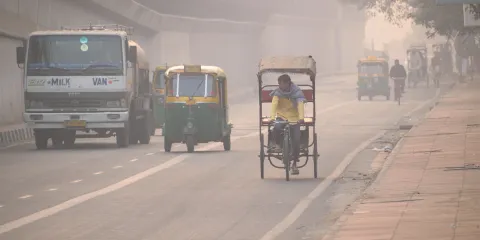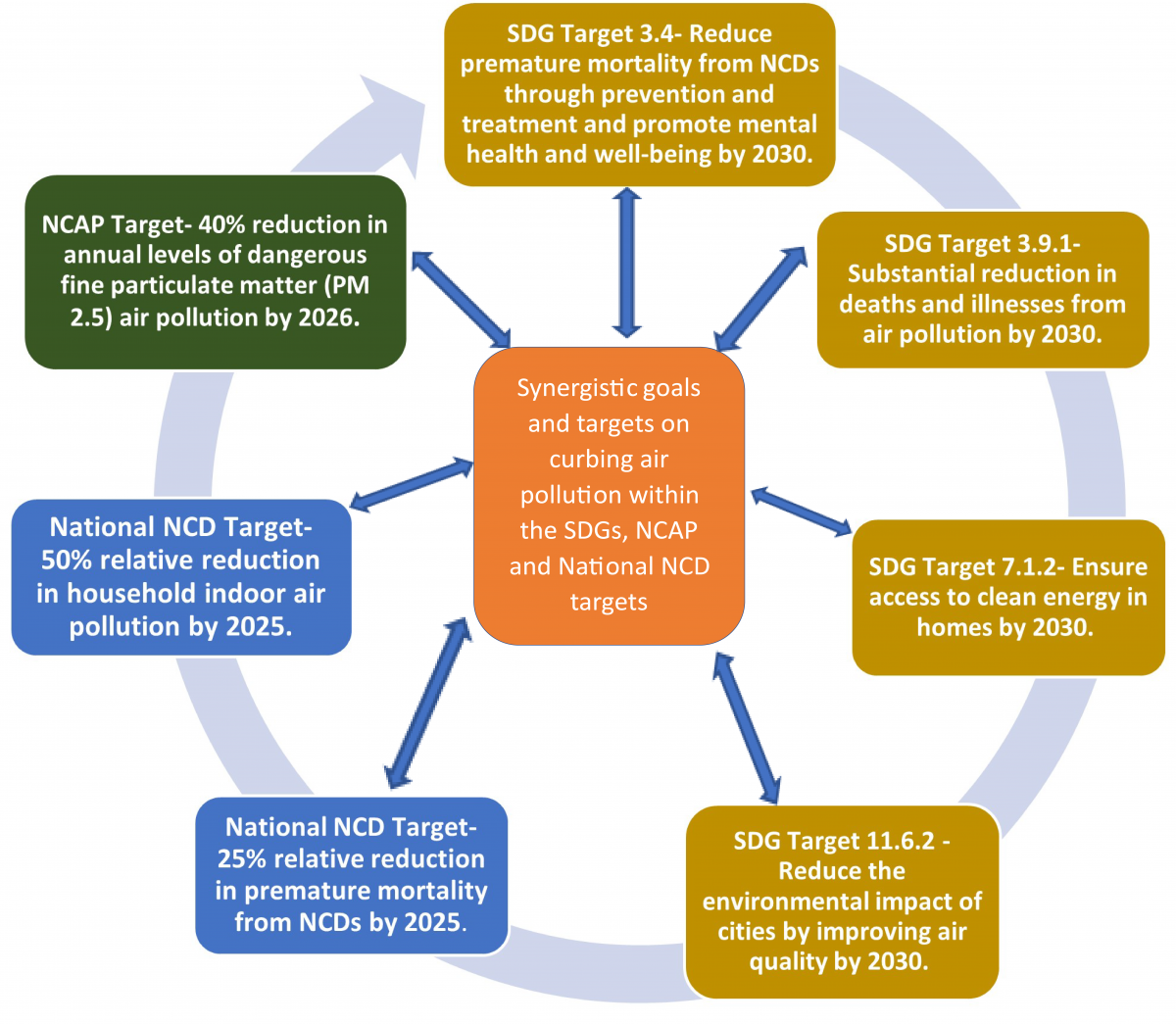Controlar la contaminación del aire en el país más poblado del mundo

La contaminación del aire es el mayor riesgo ambiental para la salud del mundo y uno de los principales factores de riesgo de enfermedades no transmisibles (ENT). Es responsable de más de 7 millones de muertes, casi el 12% de todas las muertes a nivel mundial, y algunas estimaciones son mucho más altas. Los países de ingresos bajos y medianos (PIBM) enfrentan la carga más pesada de la contaminación del aire, con más del 90% de las muertes prematuras ocurriendo en los PIBM.
Entre estos países se encuentra el más poblado del mundo: India, que está lidiando con serias amenazas por la contaminación del aire y el cambio climático. Según el Informe IQAir 2022, India ocupó el octavo lugar en la lista de países más contaminados y alberga 39 de las 50 ciudades más contaminadas del mundo. En 2019, la contaminación del aire en la India contribuyó a, al menos, 1,67 millones de muertes, y la pérdida de 1,36 por ciento del PIB (equivalente a US$36.800 millones). Varias investigaciones destacan la contaminación del aire como el contribuyente número uno a las principales ENT en el país. En respuesta a la creciente carga de ENT (65% del total de muertes en India en 2019) y para alcanzar los Objetivos de Desarrollo Sostenible (ODS), abordar la contaminación del aire es urgente.

Figura 1: Metas y objetivos sinérgicos para frenar la contaminación del aire en los ODS y las metas nacionales para las ENT. (Fuente de la imagen - HIA)
Civil society pushing the clean air agenda
Sociedad civil impulsando la agenda de aire limpio
La agenda unificadora de los ODS se alinea con los objetivos nacionales de ENT de la India y el objetivo del Programa Nacional de Aire Limpio (NCAP). De hecho, en los últimos dos años se ha prestado más atención a la contaminación del aire en el país, particularmente a través de la implementación de varios programas nacionales yasignaciones presupuestarias para la gestión de la calidad del aire. Healthy India Alliance ha estado haciendo su parte en la amplificación de estas iniciativas.
Nos complace informar que los principales ministerios y agencias están implementando programas y políticas emblemáticos para abordar la contaminación del aire en la India, incluida la Junta Central de Control de la Contaminación (CPCB) con el Ministerio de Medio Ambiente, Bosques y Cambio Climático (MoEFCC), y el Centro Nacional para el Control de Enfermedades (NCDC) con el Ministerio de Salud y Bienestar Familiar (MoHFW). El Programa Nacional de Monitoreo de la Calidad del Aire (NAMP), NCAP y el Programa Nacional para el Cambio Climático y la Salud Humana (NPCCHH) se encuentran entre los programas clave que apuntan a mitigar esta amenaza para la salud humana y planetaria en India.
Como parte del Programa Acelerador de Prevención de ENT del Instituto de Incidencia de la Alianza de ENT, con el apoyo de la Agencia Sueca de Cooperación Internacional para el Desarrollo, HIA llevó a cabo un análisis de la situación nacional sobre las ENT y la contaminación del aire en la India. Se llevó a cabo una revisión documental, diálogos con partes interesadas clave y una encuesta de opinión pública para recopilar información sobre la prevención y el control de las ENT en la India con un enfoque en la contaminación del aire. Organizamos una Consulta Nacional de la Sociedad Civil sobre ENT y Contaminación del Aire para reunir a importantes partes interesadas para identificar y discutir oportunidades, desafíos y prioridades estratégicas para la acción. Participaron representantes de MoHFW, MoEFCC, el Gobierno de la India, la OMS, el Programa de las Naciones Unidas para el Medio Ambiente (India), el Programa de las Naciones Unidas para el Desarrollo (India), el NCDC y el CPCB.
Recomendaciones para impulsar una política informada
A través de este trabajo, pudimos hacer algunas recomendaciones clave. Por ejemplo, está claro que para una respuesta nacional integral a las ENT en la India, la contaminación del aire debe posicionarse como un problema crítico de salud pública, y no solo como un problema ambiental. Otras recomendaciones se centraron en temas como priorizar la coordinación multisectorial y de múltiples partes interesadas, identificar sinergias entre las ENT clave y los programas centrados en la contaminación del aire, integrar la experiencia de las personas que viven con ENT en las estrategias de mitigación de la contaminación del aire y fortalecer la base de evidencia sobre los vínculos de ENT y contaminación del aire.
La EIS sintetizará los hallazgos clave de nuestro trabajo en una publicación científica, que exigirá una acción integrada sobre las ENT y la contaminación del aire. También planeamos aprovechar el poder de un marco de múltiples partes interesadas, obteniendo el apoyo de varios socios nacionales, regionales y globales. Hemos desarrollado y lanzado varios recursos impactantes, brindando información valiosa para informar el desarrollo de políticas. Estos incluyen el informe de Análisis Situacional Nacional, el microdocumental sobre las ENT y la contaminación del aire, un resumen de políticas sobre mitigación de la contaminación del aire, y un informe de sensibilización: Actuemos sobre las ENT y la contaminación del aire. Este tipo de enfoque multisectorial de toda la sociedad es esencial para una mitigación sólida de la contaminación del aire en la India y en todos los países del mundo.
Radhika Shrivastav es directora sénior de HRIDAY y dirige la Secretaría de Healthy India Alliance. También es miembro de la Junta de Gobierno de HIA. Trabaja para abordar las ENT desde una perspectiva de salud y desarrollo, particularmente en el contexto del Objetivo 3.4 de los ODS. Tiene dos maestrías en Nutrición y Salud Pública.
Dra. Barsa Priyadarshini Rout trabaja como Oficial de Proyectos en HRIDAY. Ella coordina las actividades de Healthy India Alliance que fomentan la participación de las OSC multisectoriales para abordar las ENT a través de una participación significativa de las OSC, las personas que viven con ENT y jóvenes. Es experta en salud pública con una Maestría en Salud Pública del Instituto Indio de Salud Pública, Gandhinagar, India.